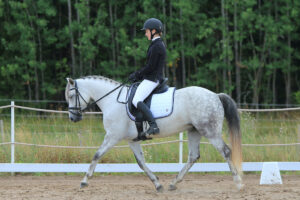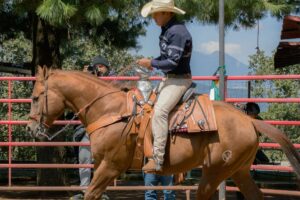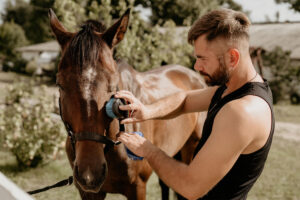
In the world of equestrian sports, the canter is a fundamental gait that plays a crucial role in the performance of jumping. A well-executed canter not only enhances the horse’s ability to clear obstacles with precision but also contributes to the overall success and safety of the rider. This article will explore the key factors that contribute to achieving superior canter quality for successful jumping, providing valuable insights and techniques for riders and trainers alike.
Understanding the Canter:
The canter is a three-beat gait that showcases the horse’s athleticism and balance. It is characterized by a distinct sequence of footfalls, consisting of the outside hind, diagonal pair (inside hind and outside fore), and inside fore. The quality of the canter is influenced by various factors, including rhythm, balance, impulsion, and suppleness. By focusing on these aspects, riders can enhance their horse’s canter and consequently improve their jumping performance.

Rhythm and Balance:
Rhythm and balance are foundational elements of a high-quality canter. Establishing a steady and consistent rhythm allows the horse to maintain a controlled and fluid motion throughout the jumping course. A rider must strive for a balanced seat and position to help their horse maintain equilibrium during the canter. Maintaining balance enables the horse to approach and navigate obstacles with accuracy and confidence.
Impulsion and Engagement:
Impulsion refers to the energy and forward drive generated from the hindquarters, propelling the horse forward into the jump. A powerful and engaged hind end allows the horse to push off the ground efficiently, resulting in better elevation and clearance over obstacles. Riders can encourage impulsion by using well-timed aids, such as leg and seat cues, to encourage the horse’s engagement and responsiveness.
Suppleness and Flexibility:
Suppleness and flexibility are essential qualities that contribute to a horse’s overall athleticism and agility. A supple horse is more able to adapt and adjust to the demands of the jumping course. Through regular exercises and training, riders can improve their horse’s suppleness by working on lateral movements, circles, and transitions. Flexibility in the horse’s body ensures smooth transitions and effortless adjustments during the canter, ultimately aiding in successful jumps.

Developing the Canter:
To achieve superior canter quality for jumping, it is vital to develop and strengthen the horse’s canter through targeted exercises and training techniques. Here are a few strategies to consider:
- Canter Poles: Incorporate canter pole work into your training routine. Set up a series of poles at specific distances to encourage the horse to find a consistent and balanced rhythm. Canter poles help improve the horse’s adjustability and coordination, enhancing their jumping technique.
- Grid Work: Progress to grid work, which involves a series of jumps set at varying distances and heights. This exercise challenges the horse’s ability to maintain impulsion, balance, and accuracy while navigating multiple obstacles. Grid work is a valuable tool for developing the horse’s technique and building confidence in both horse and rider.
- Transitions: Practice canter-walk and canter-trot transitions to develop the horse’s adjustability and responsiveness. Smooth and prompt transitions improve the horse’s balance, engagement, and obedience to aids, all of which contribute to a higher-quality canter.
- Lateral Movements: Incorporate lateral movements, such as leg yields and shoulder-in, into your training sessions. These exercises improve the horse’s suppleness and strengthen their ability to bend and flex their body. Lateral movements also enhance the horse’s coordination and balance, which are vital for successful jumping.
- Hill Work: Utilize natural terrain to your advantage. Incorporate hill work into your training program to strengthen the horse’s hindquarters and improve overall fitness. Hill work promotes impulsion, engagement, and balance while challenging the horse physically.
Conclusion:
Achieving superior canter quality is a crucial aspect of successful jumping in equestrian sports. By focusing on rhythm, balance, impulsion, and suppleness, riders and trainers can enhance their horse’s canter, leading to improved jumping technique and performance. Implementing targeted exercises such as canter poles, grid work, transitions, lateral movements, and hill work can help develop a high-quality canter, ensuring that both horse and rider are well-prepared for the challenges of the jumping course. With consistent training and dedication, riders can establish a solid foundation and pave the way for successful jumping endeavors.






